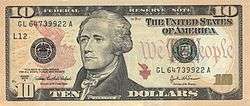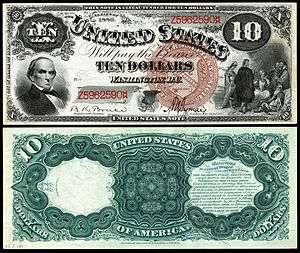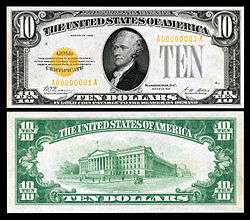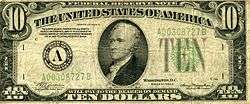United States ten-dollar bill
| (United States) | |
|---|---|
| Value | $10 |
| Width | 155.956 mm |
| Height | 66.294 mm |
| Weight | Approx. 1 g |
| Security features | Security thread, EURion constellation, Watermark, Color shifting ink, Microprinting |
| Paper type | Cotton-linen |
| Years of printing | 1861–present |
| Obverse | |
 | |
| Design | Alexander Hamilton |
| Design date | 2006 |
| Reverse | |
 | |
| Design | U.S. Treasury |
| Design date | 2006 |
The United States ten-dollar bill ($10) is a denomination of U.S. currency. The first U.S. Secretary of the Treasury (1789–95), Alexander Hamilton, is currently featured on the obverse of the bill, while the U.S. Treasury Building is featured on the reverse. Hamilton is one of two non-presidents featured on currently issued U.S. bills, the other being Benjamin Franklin on the $100 bill. Hamilton is one of only four people featured on U.S. paper currency (1861 to the present) who were not born in the continental United States; he was from the West Indies. The others were: Albert Gallatin, Switzerland ($500 1862/63 Legal Tender); George Meade, Spain ($1,000 1890/91 Treasury Note); and Robert Morris, England ($1,000 1862/63 Legal Tender; $10 1878/80 Silver Certificate). In addition, Kamehameha I appears on the 2008 Hawaii state quarter. All $10 bills issued today are Federal Reserve Notes.
As of December 2013, the average life of a $10 bill is 4.5 years, or about 54 months, before it is replaced due to wear.[1] Ten-dollar bills are delivered by Federal Reserve Banks in yellow straps.
The source of the face on the $10 bill is John Trumbull’s 1805 portrait of Hamilton that belongs to the portrait collection of New York City Hall. The $10 bill is the only U.S. paper currency in circulation in which the portrait faces to the left (the $100,000 bill featured a portrait of Woodrow Wilson facing to the left, but was used only for intra-government transactions).
In 2015 it was announced that the obverse portrait of Hamilton would be replaced by the portrait of an as yet undecided woman, starting in 2020.[2] The Secretary also made clear, however, that Hamilton would continue to be on the bill in some form.
Large size note history
(approximately 7.4218 × 3.125 in ≅ 189 × 79 mm)


- 1861: The first $10 bill was issued as a Demand Note with a small portrait of Abraham Lincoln on the left side of the obverse and an allegorical figure representing art on the right.
- 1862: The first $10 United States Note was issued with a face design similar to the 1861 Demand Note; the reverse, however, was somewhat revised.
- 1863: Interest Bearing Notes, featuring a portrait of Salmon P. Chase and vignette of liberty, were issued that could be redeemed one year after the date printed on the bill for $10 plus 5% interest. The notes could also be spent for exactly $10.
- 1864: Compound Interest Treasury Notes, with a face design similar to the 1863 Interest Bearing Note, were issued that grew in face value 6% compounded semi-annually. It is unknown if the note could actually be spent for $10 plus interest.
- 1869: A new $10 United States Note was issued with a portrait of Daniel Webster on the left and an allegorical representation of Pocahontas being presented to the Royal Court of England on the right side of the obverse. This note is nicknamed a "jackass note" because the eagle on the front looks like a donkey when the note is turned upside down.
- 1870: National Gold Bank Notes, featuring a vignette of Benjamin Franklin flying a kite on the left and liberty and an eagle on the right, were issued specifically for payment in gold coin by participating national banks. The back of the bill featured a vignette of U.S. gold coins.

- 1875: The 1869 United States Note was revised. The blue and green tinting that was present on the obverse was removed and the design on the reverse was completely changed.
- 1878: The first $10 silver certificate was issued with a portrait of Robert Morris on the left side of the obverse. The reverse, unlike any other federally issued note, was printed in black ink and featured the word SILVER in large block letters.
- 1879: Refunding Certificates were issued that paid 4% interest annually.
- 1886: A new $10 silver certificate with a portrait of Thomas A. Hendricks was issued.
- 1890: Ten-dollar Treasury or "Coin Notes" were issued and given for government purchases of silver bullion from the silver mining industry. The note featured a portrait of General Philip Sheridan. The reverse featured an ornate design that took up almost the entire note.
- 1891: The reverse of the 1890 Treasury Note was redesigned because the treasury felt that it was too "busy" which would make it too easy to counterfeit.

- 1901: The famous United States Note featuring portraits of Meriwether Lewis on the left, William Clark on the right, and an American bison which is sometimes erroneously noted as being Black Diamond, the Bison which was depicted on the reverse of the Indian Head Nickel. This United States Note was the only one to mention the legal provision that authorized its issuance. The reverse featured an allegorical figure representing Columbia between two Roman-styled pillars.
- 1907: Congress officially ended the interest paid on Refunding Certificates, forever making their face value $21.30.
- 1907: The first $10 gold certificate with a portrait of Michael Hillegas on the front and orange-colored back was issued.
- 1914: The first $10 Federal Reserve Note was issued with a portrait of Andrew Jackson on the obverse and vignettes of farming and industry on the reverse. The note initially had a red treasury seal and serial numbers; however, they were changed to blue.

- 1915: Federal Reserve Bank Notes (not to be confused with Federal Reserve Notes) were issued by 4 individual Federal Reserve banks. The obverse was similar to the 1914 Federal Reserve notes except for large wording in the middle of the bill and a portrait with no border on the left side of the bill. Each note was an obligation of the issuing bank and could only be redeemed at the corresponding bank.
- 1918: The 1915 Federal Reserve Bank Note was re-issued under series of 1918 by 4 Federal Reserve banks.
- 1923: The $10 United States Note was redesigned with a portrait of Andrew Jackson. Some of the design aspects of this note, such as the bottom border and numeral 10 overprinted with the word TEN, were transferred over to the series of 1928 $10 bill.
Small size note history



(6.14 × 2.61 in ≅ 156 × 66 mm)
- 1929: Under the Series of 1928, all U.S. currency was changed to its current size. All variations of the $10 bill would carry the same portrait of Alexander Hamilton, same border design on the obverse, and the same reverse with a vignette of the U.S. Treasury building. The $10 bill was issued as a Federal Reserve Note with a green seal and serial numbers and as a gold certificate with a golden seal and serial numbers. The car parked outside of the Treasury Department building is based on a number of different cars manufactured at the time and was the creation of the Bureau designer who developed the artwork that served as a model for the engraving, because government agencies were prohibited from endorsing any specific manufacturer or product, according to a bureau of engraving and printing pamphlet.[3] The tiny building to the right rear of the treasury building is the American Security and Trust Company Building, which for some years advertised itself as "right on the money".[4][5]
- 1933: As an emergency response to the Great Depression, additional money was pumped into the American economy through Federal Reserve Bank Notes. This was the only small-sized $10 bill that had a different border design on the obverse. The serial numbers and seal on it were brown.
- 1933: The first small sized $10 silver certificates were issued with a blue seal and serial numbers. The obverse had a similar design style to the 1928 $1 Silver Certificates; however, phrasing on the $10 bill was different from the $1 bill. This issue, with the series date of 1933, was not widely released into general circulation. Surviving examples of these notes usually sell for $10,000 to $30,000 in the numismatic community depending on the condition of the paper.
- 1934: The redeemable in gold clause was removed from Federal Reserve Notes due to the U.S. withdrawing from the gold standard.
- 1934: The $10 Silver Certificate was redesigned with a blue numeral 10 on the left side of the obverse and the treasury seal printed over the gray word TEN on the right. Phrasing on the certificate was changed to reflect the Silver Purchase Act of 1934.
- 1942: Special World War II currency was issued. HAWAII was overprinted on the front and back of the $10 Federal Reserve Note, and the seal and serial numbers were changed to brown. This was done so that the currency could be declared worthless in case of Japanese invasion. A $10 Silver Certificate was printed with a yellow instead of blue treasury seal; these notes were given to U.S. troops in North Africa. These notes, too, could be declared worthless if seized by the enemy.
- 1950: Many minor aspects on the obverse of the $10 Federal Reserve Note were changed. Most noticeably, the treasury seal, gray word TEN, and the Federal Reserve Seal were made smaller, the words WASHINGTON, D.C. were added between them and the serial number; also, the Federal Reserve seal had spikes added around it.
- 1953: The $10 silver certificate had several design changes analogous to the 1950 Federal Reserve Note design changes; also, the blue numeral 10 on the left side of the bill was changed to gray.
- 1963: WILL PAY TO THE BEARER ON DEMAND was removed from the obverse and {{small|IN GOD WE TRUST}} was added to the reverse of the $10 Federal Reserve Notes. Also, the obligation was shortened to its current wording, THIS NOTE IS LEGAL TENDER FOR ALL DEBTS, PUBLIC AND PRIVATE.
- 1969: The $10 bill began using the new treasury seal with wording in English that simply says, "The Department of the Treasury," instead of Latin "THESAUR. AMER. SEPTENT. SIGIL.," "Seal of the Treasury of North America."
- 1981: During production of Series 1977A, a few star notes from the Richmond FRB were made on experimental Natick paper, in the only experimental note series not involving the $1 bill.
- 1992: The first modern anti-counterfeiting measures were introduced with microscopic printing around Hamilton's portrait and a plastic security strip on the left side of the bill. Even though the notes read Series 1990, the first bills were printed in July 1992.[6]
- May 24, 2000: To combat evolving counterfeiting, a new $10 bill was issued under series 1999 whose design was similar in style to the $100, $50, $20, and $5 bills that had all undergone previous design changes. The major changes were a revised portrait of Hamilton and a revised vignette of the U.S. Treasury building, now facing front. The plastic security strip reads "USA TEN" and now glows orange under a black light. Like the new $5, the bills were first printed in December 1999.[7]
- March 2, 2006: In addition to design changes introduced in 2000, the obverse features red background images of the Statue of Liberty's torch, the phrase WE THE PEOPLE from the United States Constitution, a smaller metallic representation of the Statue of Liberty's torch, orange and yellow background color, a borderless portrait of Hamilton, and to the left of Hamilton small yellow 10s whose zeros form the EURion constellation. The reverse features small yellow EURion 10s and have the fine lines removed from around the vignette of the United States Treasury building. These notes were issued in series 2004A with Cabral-Snow signatures. The first notes were printed in July 2005.[8]
Future redesign
On June 17, 2015, Treasury Secretary Jack Lew announced that a woman's portrait would be featured on a redesigned ten-dollar bill by 2020. The Department of Treasury is seeking the public's input on who should appear on the new bill.[2][9] When asked about which woman should replace Hamilton during a televised debate in September 2015, GOP candidate Jeb Bush suggested the portrait of the late British prime minister Margaret Thatcher. [10]
The next redesigned ten-dollar bill will be the first U.S. note to incorporate tactile features to assist those with visual disabilities.[11]
See also
References
- ↑ http://www.federalreserve.gov/faqs/how-long-is-the-life-span-of-us-paper-money.htm
- 1 2 "Secretary Lew Announces Historic Decision To Feature A Woman On The Newly Redesigned Ten Dollar Note" (Press release). U.S. Treasury Department. June 17, 2015. Retrieved June 18, 2015.
- ↑ "Currency NOTES" (PDF). Bureau of engraving and Printing.
- ↑ Fodor's Washington DC. Random House. 1991. p. 76.
American Security Bank likes to boast in its commercials that it's "Right on the money"—"the money" in this case being a $10 bill. If you look on the back of one you'll see the Treasury Building and to its right the tiny American Security bank building.
- ↑ "Trademark search details for "Right on the money"". Boliven. Retrieved January 22, 2010.
- ↑ http://www.uspapermoney.info/serials/f1990_d.html
- ↑ http://www.uspapermoney.info/serials/f1999_d.html
- ↑ http://www.uspapermoney.info/serials/f2004ad.html
- ↑ Calmes, Jackie (June 17, 2015). "Woman’s Portrait Will Appear on the $10 Bill". The New York Times.
- ↑ https://www.washingtonpost.com/news/worldviews/wp/2015/09/17/jeb-bush-wants-margaret-thatcher-on-a-10-bill-brits-are-bemused/
- ↑ http://www.bep.gov/images/Meaningful_Access_White_Paper_06-25-13.pdf
Sources
- Wilhite, Robert (1998). Standard Catalog of United States Paper Money (17th ed). Krause Pubns Inc. ISBN 0-87341-653-8.
- Hudgeons, Thomas (2005). The Official Blackbook Price Guide to U.S. Paper Money 2006, Edition #38. House of Collectibles. ISBN 1-4000-4845-1.
- Friedberg, Arthur; Ira Friedberg; David Bowers (2005). A Guide Book Of United States Paper Money: Complete Source for History, Grading, and Prices (Official Red Book). Whitman Publishing. ISBN 0-7948-1786-6.
External links
| ||||||||||||||||||||||
